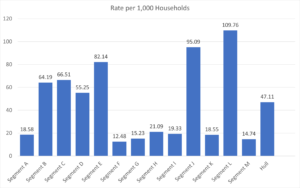Background
In 2017, Hull City’s Council’s Street Scene service successfully bid for £400,000 from the government’s Controlling Migration Fund (CMF) which is provided by the Ministry of Housing, Communities and Local Government. It is designed to help local authorities respond to the impact of international migration on their communities.
In Hull, littering, fly-tipping and poor waste containment problems are often most acute in inner city wards with the highest levels of deprivation, private rented accommodation, and the highest migrant populations.
The result: the Love Your Street project, aimed at improving environmental and housing standards across 6 key wards. It engages and empowers local communities to take ownership of and improve their surroundings. A dedicated Love Your Street team (neighbourhood wardens and housing enforcement officers) work with residents and landlords, for the benefit of all.
How Did The Insight Team Help?
Customer Segmentation
The Insight Team’s customer segmentation model sub-divides the city’s population into 13 distinct segments, based on shared characteristics, attitudes and behaviours. We used local and national datasets, linking socio–demographic information from sources such as the Census, with real, local attitudinal data from the People’s Panel, and transactional data from service requests and so on. The segments have been mapped onto all areas of the city and they provide a detailed and accurate understanding of residents and where they are in the city.
The model provides Hull City Council and its partners with a strategic tool to support and enhance how and where public services are delivered. The segments help us to:
- Understand who uses public services, to what extent, and in what combinations, so we can manage and anticipate customer need, now and in the future
- Allocate resources more efficiently by targeting services specifically at the people who either need or want them
- Increase public satisfaction through improved service design – providing services based on an understanding of how customers prefer to access them
- Create personalised marketing that increases service take up or which can nudge or trigger changes in behaviour
- Realise greater value from research and consultation – identifying further differences and/or similarities in the behaviours and attitudes of different population subgroups
You can find out more about the segmentation model here: Hull Data Observatory – Customer Insight
So how did we use this?
- Demonstrating the Link Between Areas of Greater Environmental Problems and High Migrant Populations
For the bid to be successful it needed to show both the community need and that this is the result of recent migration.
The Waste Management Team provided us with fully post coded data on the 5,495 fly tipping incidents across Hull in 2016. Full postcodes meant we could match the incidents to our customer segments.
By calculating the fly tipping rate per 1,000 households within each segment we were able to evidence that fly tipping (and so community need) was significantly higher amongst three segments – specifically segments E, J and L.

We were then able to cross reference this with information we hold about the nationality, ethnicity and language ability of residents of each of our segments.
This demonstrated that the segments with the greatest community need for the project are all also associated with areas with larger ethnically diverse populations including newer migrant communities.
- Helping to Focus Resources
The data suggests that the project should be targeting areas of the city where these three segments are most prevalent. Using the segment model we were able to identify, for the bid, the six wards where these groups were most prevalent:
- Central (previously Myton)
- University
- Avenue
- Beverley and Newland
- Newington and Gipsyville
- St Andrews and Docklands
In further work after the successful bid, the segment data was also cross referenced with the fly tipping data at Lower Super Output Area (LSOA) level. This meant we could identify and prioritise the actions of the project right down to a postcode / street level.
Project Evaluation
Once the Love Your Street project had been operational for a year, The Insight Team produced a bespoke questionnaire to collect the views of local residents on how their area had changed in that year and what issues they still faced. These evaluation surveys were undertaken in the areas targeted by the project, both on paper and using tablet devices.
Because the survey met Corporate Research and Consultation Standards; we were also able to assist in analysing and reporting the results.
View the results of the Love Your Street Community Environmental Improvement Survey
This information was then used as an integral part of an additional and successful bid to the CMF in 2018 for £120,000 further funding to extend the project and to expand the Love Your Street team.
The Waste Management Team collect quality, robust data that meets the corporate standards in terms of what they collect, and how they collect it. This is why the Insight Team is able to produce highly robust and valuable analysis for them and why the Waste Management team has been able to make successful bids, such as this one.
